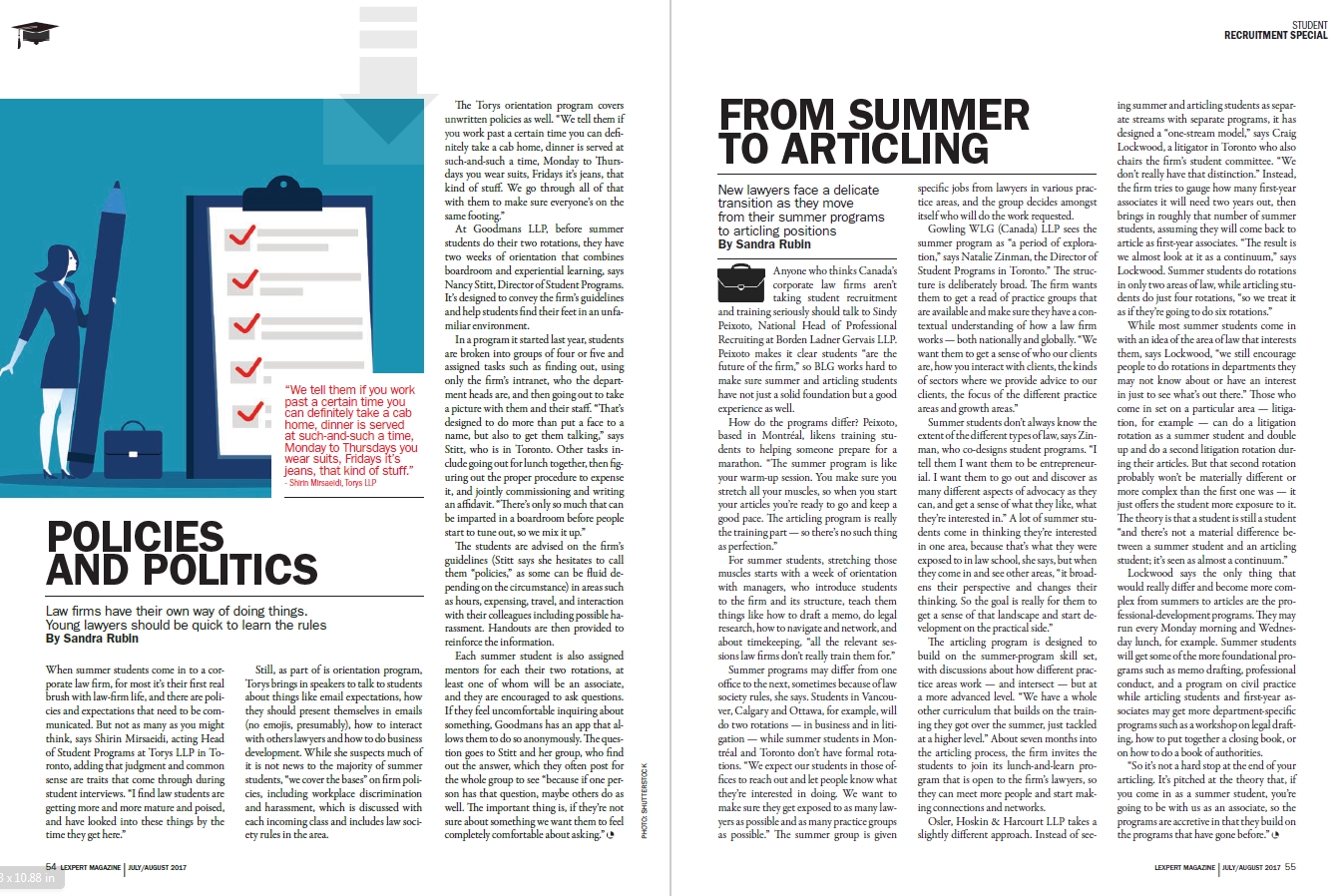ANYONE WHO THINKS CANADA'S CORPORATE law firms aren’t taking student recruitment and training seriously should talk to Sindy Peixoto, National Head of Professional Recruiting at Borden Ladner Gervais LLP. Peixoto makes it clear students “are the future of the firm,” so BLG works hard to make sure summer and articling students have not just a solid foundation but a good experience as well.
How do the programs differ? Peixoto, based in Montréal, likens training students to helping someone prepare for a marathon. “The summer program is like your warm-up session. You make sure you stretch all your muscles, so when you start your articles you’re ready to go and keep a good pace. The articling program is really the training part — so there’s no such thing as perfection.”
For summer students, stretching those muscles starts with a week of orientation with managers, who introduce students to the firm and its structure, teach them things like how to draft a memo, do legal research, how to navigate and network, and about timekeeping, “all the relevant sessions law firms don’t really train them for.”
Summer programs may differ from one office to the next, sometimes because of law society rules, she says. Students in Vancouver, Calgary and Ottawa, for example, will do two rotations — in business and in litigation — while summer students in Montréal and Toronto don’t have formal rotations. “We expect our students in those offices to reach out and let people know what they’re interested in doing. We want to make sure they get exposed to as many lawyers as possible and as many practice groups as possible.” The summer group is given specific jobs from lawyers in various practice areas, and the group decides amongst itself who will do the work requested.
Gowling WLG (Canada) LLP sees the summer program as “a period of exploration,” says Natalie Zinman, the Director of Student Programs in Toronto.” The structure is deliberately broad. The firm wants them to get a read of practice groups that are available and make sure they have a contextual understanding of how a law firm works — both nationally and globally. “We want them to get a sense of who our clients are, how you interact with clients, the kinds of sectors where we provide advice to our clients, the focus of the different practice areas and growth areas.”
Summer students don’t always know the extent of the different types of law, says Zinman, who co-designs student programs. “I tell them I want them to be entrepreneurial. I want them to go out and discover as many different aspects of advocacy as they can, and get a sense of what they like, what they’re interested in.” A lot of summer students come in thinking they’re interested in one area, because that’s what they were exposed to in law school, she says, but when they come in and see other areas, “it broadens their perspective and changes their thinking. So the goal is really for them to get a sense of that landscape and start development on the practical side.”
The articling program is designed to build on the summer-program skill set, with discussions about how different practice areas work — and intersect — but at a more advanced level. “We have a whole other curriculum that builds on the training they got over the summer, just tackled at a higher level.” About seven months into the articling process, the firm invites the students to join its lunch-and-learn program that is open to the firm’s lawyers, so they can meet more people and start making connections and networks.
Osler, Hoskin & Harcourt LLP takes a slightly different approach. Instead of seeing summer and articling students as separate streams with separate programs, it has designed a “one-stream model,” says Craig Lockwood, a litigator in Toronto who also chairs the firm’s student committee. “We don’t really have that distinction.” Instead, the firm tries to gauge how many first-year associates it will need two years out, then brings in roughly that number of summer students, assuming they will come back to article as first-year associates. “The result is we almost look at it as a continuum,” says Lockwood. Summer students do rotations in only two areas of law, while articling students do just four rotations, “so we treat it as if they’re going to do six rotations.”
While most summer students come in with an idea of the area of law that interests them, says Lockwood, “we still encourage people to do rotations in departments they may not know about or have an interest in just to see what’s out there.” Those who come in set on a particular area — litigation, for example — can do a litigation rotation as a summer student and double up and do a second litigation rotation during their articles. But that second rotation probably won’t be materially different or more complex than the first one was — it just offers the student more exposure to it. The theory is that a student is still a student “and there’s not a material difference between a summer student and an articling student; it’s seen as almost a continuum.”
Lockwood says the only thing that would really differ and become more complex from summers to articles are the professional-development programs. They may run every Monday morning and Wednesday lunch, for example. Summer students will get some of the more foundational programs such as memo drafting, professional conduct, and a program on civil practice while articling students and first-year associates may get more department-specific programs such as a workshop on legal drafting, how to put together a closing book, or on how to do a book of authorities.
“So it’s not a hard stop at the end of your articling. It’s pitched at the theory that, if you come in as a summer student, you’re going to be with us as an associate, so the programs are accretive in that they build on the programs that have gone before.”
How do the programs differ? Peixoto, based in Montréal, likens training students to helping someone prepare for a marathon. “The summer program is like your warm-up session. You make sure you stretch all your muscles, so when you start your articles you’re ready to go and keep a good pace. The articling program is really the training part — so there’s no such thing as perfection.”
For summer students, stretching those muscles starts with a week of orientation with managers, who introduce students to the firm and its structure, teach them things like how to draft a memo, do legal research, how to navigate and network, and about timekeeping, “all the relevant sessions law firms don’t really train them for.”
Summer programs may differ from one office to the next, sometimes because of law society rules, she says. Students in Vancouver, Calgary and Ottawa, for example, will do two rotations — in business and in litigation — while summer students in Montréal and Toronto don’t have formal rotations. “We expect our students in those offices to reach out and let people know what they’re interested in doing. We want to make sure they get exposed to as many lawyers as possible and as many practice groups as possible.” The summer group is given specific jobs from lawyers in various practice areas, and the group decides amongst itself who will do the work requested.
Gowling WLG (Canada) LLP sees the summer program as “a period of exploration,” says Natalie Zinman, the Director of Student Programs in Toronto.” The structure is deliberately broad. The firm wants them to get a read of practice groups that are available and make sure they have a contextual understanding of how a law firm works — both nationally and globally. “We want them to get a sense of who our clients are, how you interact with clients, the kinds of sectors where we provide advice to our clients, the focus of the different practice areas and growth areas.”
Summer students don’t always know the extent of the different types of law, says Zinman, who co-designs student programs. “I tell them I want them to be entrepreneurial. I want them to go out and discover as many different aspects of advocacy as they can, and get a sense of what they like, what they’re interested in.” A lot of summer students come in thinking they’re interested in one area, because that’s what they were exposed to in law school, she says, but when they come in and see other areas, “it broadens their perspective and changes their thinking. So the goal is really for them to get a sense of that landscape and start development on the practical side.”
The articling program is designed to build on the summer-program skill set, with discussions about how different practice areas work — and intersect — but at a more advanced level. “We have a whole other curriculum that builds on the training they got over the summer, just tackled at a higher level.” About seven months into the articling process, the firm invites the students to join its lunch-and-learn program that is open to the firm’s lawyers, so they can meet more people and start making connections and networks.
Osler, Hoskin & Harcourt LLP takes a slightly different approach. Instead of seeing summer and articling students as separate streams with separate programs, it has designed a “one-stream model,” says Craig Lockwood, a litigator in Toronto who also chairs the firm’s student committee. “We don’t really have that distinction.” Instead, the firm tries to gauge how many first-year associates it will need two years out, then brings in roughly that number of summer students, assuming they will come back to article as first-year associates. “The result is we almost look at it as a continuum,” says Lockwood. Summer students do rotations in only two areas of law, while articling students do just four rotations, “so we treat it as if they’re going to do six rotations.”
While most summer students come in with an idea of the area of law that interests them, says Lockwood, “we still encourage people to do rotations in departments they may not know about or have an interest in just to see what’s out there.” Those who come in set on a particular area — litigation, for example — can do a litigation rotation as a summer student and double up and do a second litigation rotation during their articles. But that second rotation probably won’t be materially different or more complex than the first one was — it just offers the student more exposure to it. The theory is that a student is still a student “and there’s not a material difference between a summer student and an articling student; it’s seen as almost a continuum.”
Lockwood says the only thing that would really differ and become more complex from summers to articles are the professional-development programs. They may run every Monday morning and Wednesday lunch, for example. Summer students will get some of the more foundational programs such as memo drafting, professional conduct, and a program on civil practice while articling students and first-year associates may get more department-specific programs such as a workshop on legal drafting, how to put together a closing book, or on how to do a book of authorities.
“So it’s not a hard stop at the end of your articling. It’s pitched at the theory that, if you come in as a summer student, you’re going to be with us as an associate, so the programs are accretive in that they build on the programs that have gone before.”





